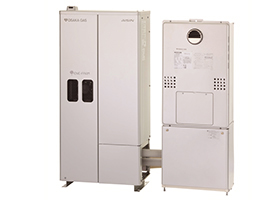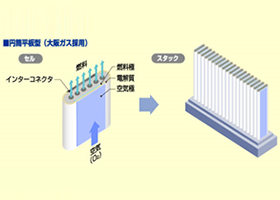Fuel Cell systems
Next-Generation Quality Management Activities for Ene-Farm Using IoT
- Overview
- About Next-Generation Quality Management Activities
- About Measures for Installed Equipment with and without IoT-Connected Systems (Always Connected)
- About Failure Prediction Logic
- Example of Failure Prediction Using Unsupervised Learning (Mismeasurement Due to a Flow Meter)
- Effects of Activities and Future Initiatives
Overview
Since FY2016, Osaka Gas has been using IoT to remotely collect equipment information from Ene-Farm (type S) and to carry out quality control using data analysis technology while also working to reduce failure at each site.
About Next-Generation Quality Management Activities
The goals for our next-generation quality management activities are to “start quality improvement before the first failure,” “improve the quality of installed equipment without visiting customers' homes,” “prevent failures before they occur by using AI technology-based failure prediction logic,” and “eliminate failures early in the development stage of the next model.”
Since 2016, it has become possible to collect and monitor the operation data of installed, always connected Ene-Farm units in real time. Initial failures caused by manufacturing variations and other issues are detected early for working out measures. Accordingly, equipment control has been enhanced and quality improvement has been achieved remotely without the need to visit customers' homes.
Moreover, by using big data obtained through constant connection and AI technology, we have developed failure prediction logic that detects deviations from normal operating data that would be unnoticeable to the human. This makes it possible to begin investigating the cause and grasp the tendency toward frequent failures before the failure becomes apparent.
We are currently utilizing this logic in the development stage of our next models to ensure and improve quality.
About Measures for Installed Equipment with and without IoT-Connected Systems (Always Connected)
With a constant connection, it is possible to begin investigating the causes and preparing measures as soon as an increasing trend in failures is identified. A constant connection also enables data for all pieces of installed equipment to be monitored, which shortens the time it takes to release measures.
In addition, even if a visit to a customer's home is necessary, temporary measures can be implemented remotely to quickly mitigate any faults before we begin visiting.
On the other hand, where no constant connection is available, even if the process of identifying the failure, investigating the cause, and preparing measures is the same as above, it will subsequently take time to identify an increasing trend in failures, and preparations for developing measures will be delayed. As a result, we might begin visiting the sites of installed pieces of equipment at a time when there are many failures with them.
Thus, with a constant connection, it is possible to use big data to confirm the increasing trend in failures, quickly identify the cause, and implement measures.
About Failure Prediction Logic
For older models with which specific failures have been known to occur frequently, we use two methods to predict failures: supervised learning, which makes judgments based on the strength of correlation with specific failures, and unsupervised learning, which uses errors and deviations detected in comparison with normal data to make judgments.
Regarding failure prediction based on supervised learning, operation data is monitored via a constant connection. If a failure is predicted, maintenance is performed immediately or improvements are made remotely.
Regarding failure prediction using unsupervised learning, we analyze the data that predicts failure, investigate the causes, determine whether there are any abnormalities, and work out solutions to ensure quality.
Example of Failure Prediction Using Unsupervised Learning (Mismeasurement Due to a Flow Meter)
A normal diagnostic model was created using the operation data of installed, normal equipment that could be obtained through a constant connection, and the data was used to detect deviations in measurement values before an error was reported. After parts were collected and investigated, it was discovered that the cause was foreign matter adhering to the flow meter.
After that, we were able to prevent frequent failures by remotely transmitting data and reducing the risk of foreign matter adhesion before multiple errors began to occur in installed equipment.
Effects of Activities and Future Initiatives
The constant connection service began with the 2016 model, consisting of, among others, preventing failures through data transmission and quality control activities based on failure prediction. The result for the current model is a failure rate on par with that of general water heaters.
These efforts are currently made in the development stage of the next model. The goal is to maintain a stable, ultra-low failure rate by eliminating malfunctions before the model is released and by repeatedly identifying failure trends and implementing remote solutions after the model is released.
Additionally, while we are currently working on Ene-Farm, we are also devising failure prediction for water heaters, utilizing acquirable data.
In the future, we will continue to carry out proactive maintenance in order to minimize customer inconvenience and level out the maintenance workload.
Related contents
TAG SEARCH
- Evolving residential gas appliances
- Evolving residential gas appliances Water heaters, space heaters, dryers Cooking appliances Smart Equipment Fuel Cell systems
- Evolving commercial and industrial gas appliances
- Evolving commercial and industrial gas appliances Cogeneration (CHP) units Air conditioning systems, kitchen appliances Bio, water treatment Industrial furnaces, burners Energy management, IoT
- Enhancing the safety and economic efficiency of LNG regasification
- Enhancing the safety and economic efficiency of LNG regasification Utilization of cold energy Plant materials Power generation technology
- Developing next-generation businesses through enterprising initiatives
- Developing next-generation businesses through enterprising initiatives Materials development Measurement Simulation, data analysis Food science Material evaluation
- Contributing to conserving the environment and achieving a carbon neutral society
- Contributing to conserving the environment and achieving a carbon neutral society Methanation Hydrogen, ammonia Biogas Energy management Renewable Energy
- Technologies of Group companies
- KRI, Inc. Osaka Gas Chemicals Group OGIS-RI Group




